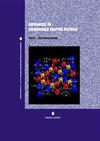化学气相沉积与湿化学相结合生长多层MoS2的有效途径
IF 1.8
4区 物理与天体物理
Q3 PHYSICS, CONDENSED MATTER
引用次数: 2
摘要
由于其半导体特性,二硫化钼(MoS2)是一种积极追求的二维家族材料,使其成为纳米和光电子应用的潜在候选者。化学气相沉积法(CVD)从钼和硫前驱体中生长二硫化钼得到了广泛的应用,但以前忽视了通过CVD将钼酸盐转化为二硫化钼。MoS2的直接生长不仅减少了界面缺陷,而且降低了器件制造的复杂性。在这项工作中,我们将湿法合成和化学气相沉积相结合,用钼酸钠和l -半胱氨酸制成溶液。用浸涂法,将混合物涂在基材上,然后用化学气相沉积法将化学物质转化为二硫化钼。拉曼光谱显示除了a1g和e2g1g之外的硫化物(峰值)的存在,其中热处理仅在氩气流存在的情况下进行。另一方面,在硫和氩气存在下,还原膜只促进了MoS2的a1g和e2g1峰,证实了完全转变。XRD衍射显示,试样的衍射峰和应变值变化很小,而SEM成像显示,在硫存在下加热后,MoS2试样形成了薄片。x射线光电子能谱也用于化学成分和了解价态Mo, S, O和其他物种。本文章由计算机程序翻译,如有差异,请以英文原文为准。
An Effective Route for the Growth of Multilayer MoS2 by Combining Chemical Vapor Deposition and Wet Chemistry
Molybdenum disulfide (MoS2) is an actively pursuing material of the 2D family due to its semiconducting characteristics, making it a potential candidate for nano and optoelectronics application. MoS2 growth from molybdenum and sulphur precursors by chemical vapor depositions (CVD) is used widely, but molybdates’ conversion into MoS2 via CVD is overlooked previously. Direct growth of MoS2 on the desired pattern not only reduces the interfacial defects but also reduces the complexities in device fabrication. In this work, we combine the wet synthesis and chemical vapor deposition method where sodium molybdate and L-cysteine are used to make a solution. With the dip coating, the mixture is coated on the substrates, and then, chemical vapor deposition is used to convert the chemicals into MoS2. Raman spectroscopy revealed the presence of oxysulphides (peaks number value) other than
A
1
g
and
E
2
g
1
, where heat treatment was performed in the presence of Ar gas flow only. On the other hand, the films reducing in the presence of sulphur and argon gas promote only
A
1
g
and
E
2
g
1
peaks of MoS2, which confirms complete transformation. XRD diffraction showed a very small change in the diffraction peaks and value of strain, whereas SEM imaging showed the flakes formation for MoS2 samples which were heated in the presence of sulphur. X-ray photoelectron spectroscopy is also performed for the chemical composition and to understand the valence state of Mo, S, and O and other species.
求助全文
通过发布文献求助,成功后即可免费获取论文全文。
去求助
来源期刊

Advances in Condensed Matter Physics
PHYSICS, CONDENSED MATTER-
CiteScore
2.30
自引率
0.00%
发文量
33
审稿时长
6-12 weeks
期刊介绍:
Advances in Condensed Matter Physics publishes articles on the experimental and theoretical study of the physics of materials in solid, liquid, amorphous, and exotic states. Papers consider the quantum, classical, and statistical mechanics of materials; their structure, dynamics, and phase transitions; and their magnetic, electronic, thermal, and optical properties.
Submission of original research, and focused review articles, is welcomed from researchers from across the entire condensed matter physics community.
 求助内容:
求助内容: 应助结果提醒方式:
应助结果提醒方式:


